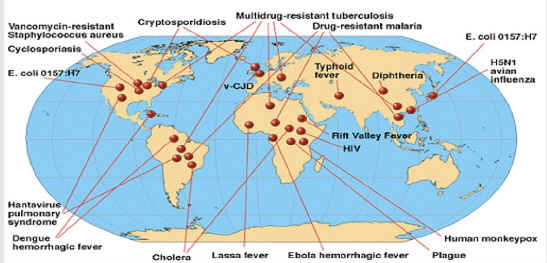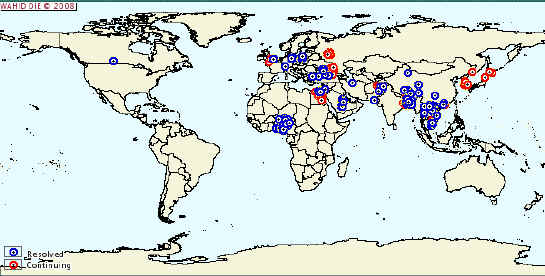



Emerging Animal Diseases and International Trade
Infectious animal and zoonotic diseases are becoming more and more important in the changing farming and trading systems of the industrialised and developing world, writes ThePoultrySite Senior Editor, Chris Harris.
Dr Alejandro A. Schudel from Fundación PROSAIA in Argentina told the World Meat Congress in Cape Town that some emerging or evolving infectious diseases have the potential to quickly spread from local to international significance or to jump species barriers, including to humans.
And he added that these diseases can have a serious impact on international trade and in the perception of the consumers with regard to the safety of animal-derived products.
"We are facing new challenges in animal diseases," Dr Schudel said.
"In the last 25 years, they have spread very quickly and have taken on a global perspective."
He said that there is a significant interaction between both human and animal health today as we face the emergence and re-emergence of animal and zoonotic diseases of unprecedented magnitude.
He said the world is at the threshold of a new era of emergent and re-emergent diseases that will have a tremendous impact on public health. The significance of its potential consequences has substantially influenced the acceptance of the concept of 'Healthy Animals, Safe Food, Healthy People'.

Dr Schudel said that this is reflected in the fact that numerous countries have established their own standards and regulations to control diseases.
The effects of globalisation, industrialisation, the restructuring of the agricultural sector, and the growing and sustained demand for animal proteins are rapidly changing the foundations and the application of policies directly related to animal health and food safety as well as to the safety of the food supply.
One important aspect is that the increase in diseases is largely in zoonotic diseases - those that can be passed from animal to human.
He estimated that 75 per cent of the emerging diseases are zoonotic.
The factors that influence the spread of disease are environmental, ecological, genetic and political. Poverty and inequality, wars and a lack of domestic political will to tackle disease all influence how it is spread around the world.
Dr Schudel added that this new scenario of worldwide health affects not only the importing and exporting countries but all countries as a whole, due to the tremendous implications that such events could have on global trade.
The recent outbreaks of Bovine Spongiform Encephalopathy (BSE) in Europe, Asia and North America, the Highly Pathogenic Avian Influenza (HPAI) epidemic that started in South East Asia and the introduction of Foot and Mouth (FMD) disease in Europe are typical examples of this new scenario.
The quick detection of these emerging, re-emerging and zoonotic diseases and the consequent reaction will be the decisive factor in order to be able to quickly overcome the threat posed by such events.
(WAHID, OIE, May 2008)

Dr Schudel said that the lessons learned from the outbreaks of these diseases are that there is a greater need for food safety measures, increased communication to the consumer and there is more awareness among the general public of issues of animal welfare and well-being.
He added that the impact of the diseases was felt by everyone - rich and poor alike - and that there was a serious financial consequence to any outbreak of disease. The 2001 UK FMD outbreak had a financial impact of £13 billion. In the US, it has been estimated that the financial costs of an outbreak of FMD would be between $7 billion and $14 billion. The cost of the HPAI outbreak in Asia has already been estimated at between $8 billion and $12 billion.
Animal health has a lot to do with food safety and healthy animals have a lot to do with safe food, he said.
The readiness of any country to face an animal emerging disease, and its capacity to respond, depend in great measure to the preparedness of its veterinary services.
The lack of infrastructures that support diagnostic laboratories, veterinarians, expert services and worldwide vigilance are insufficient, and this fact is clearly seen among developed and developing nations.
He said there is an urgent need to improve veterinary services and a need for more transparency.
Another extremely important aspect that needs to be addressed is how to alert the consumer about the science-based risks of these diseases with regard to food safety in a quick and efficient manner.
He said that the outbreaks of BSE and HPAI are cases that show the need for transparency and swift communication.
Animal Health authorities and Public Health authorities have to confront the issues in a coordinated manner.
International organizations are bringing about joint efforts, and the World Organisation for Animal Health (OIE) has clearly said it should play a role when facing the difficulties that these diseases pose on a worldwide level.
Effective global security can only be achieved if all trading countries comply with internationally agreed upon standards and guidelines, effectively training people in the industry and ensuring the availability of adequate human and material veterinary resources, and he also called for a strong global quality certification process to verify the integrity of products and the health of animals.
Many countries share a common concern about the emergence of animal diseases and zoonosis or the deliberate misuse of pathogenic biological agents that could affect the public health as well as food and animal production.
Existing methods of disease prevention and containment regulations as well as international guidelines and standards are available and should be followed in order to procure early detection and a quick containment, Dr Schudel said.
Further Reading
| - | You can view other reports from the World Meat Congress 2008 by clicking here. |
September 2008








